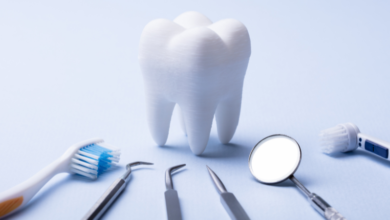Uncovering the 6 Under-Reported Side Effects of Opioid Addiction Therapy

Opioid addiction therapy is essential for recovery, but it comes with challenges beyond its primary focus. The American Medical Association estimates that 3% to 19% of prescription pain medication users develop addiction. Around 45% of heroin users start with prescription opioids.
In this article, we highlight opioid therapy’s side effects, including dental and cardiovascular risks, emphasizing the importance of addressing these health impacts.
1. The Impact on Dental Health
One of the lesser-known side effects of opioid addiction therapy, particularly when using medications like Suboxone, is its impact on dental health. Suboxone eases cravings and withdrawal symptoms by combining naloxone and buprenorphine. However, an often overlooked side effect is its impact on dental health. The medication may cause dry mouth, which decreases saliva production. Saliva is crucial for neutralizing acids and safeguarding teeth from decay.
Therefore, individuals using Suboxone may be at an increased risk of developing cavities and gum disease and experiencing a general decline in oral health. To counter these effects, it is essential to practice thorough oral hygiene, stay well-hydrated, and schedule regular dental check-ups.
A study by the National Library of Medicine highlights that oral buprenorphine is crucial in treating opioid use disorder. In January 2022, the U.S. Food and Drug Administration warned healthcare providers about the potential dental risks associated with long-term use of sublingual or buccal forms of buprenorphine. These risks include issues such as cavities or tooth loss, especially when buprenorphine is combined with naloxone.
Many experiencing severe dental issues from Suboxone are pursuing a Suboxone lawsuit. These legal actions often claim that the manufacturer failed to sufficiently warn about the risks of significant dental side effects. Lawsuits may seek compensation for medical costs, pain and suffering, and diminished quality of life due to dental problems.
According to TorHoerman Law, Suboxone settlements can range from $10,000 to over $150,000, depending on individual case details. If Suboxone has caused significant dental damage, consulting a lawyer experienced in pharmaceutical litigation can help evaluate your legal case.
How frequently should I schedule dental visits while taking Suboxone to reduce dental issues?
When taking Suboxone, it is advised to see a dentist every three to six months. Regular dental check-ups help detect issues like dry mouth, cavities, and gum disease early. Your dentist can also offer treatments such as fluoride applications and guides on maintaining good oral hygiene to minimize dental risks.
2. Gastrointestinal Issues
The medications used in treatment can lead to constipation, nausea, and abdominal discomfort, which can significantly affect the quality of life. These symptoms may become chronic, necessitating dietary changes, increased fiber intake, proper hydration, and possibly using laxatives under medical supervision.
The American Journal of Gastroenterology states opioid abuse often leads to significant gastrointestinal (GI) issues, including opioid-induced bowel dysfunction and narcotic bowel syndrome. A study involving 18 individuals with opioid addiction (average age: 54 years; 94.4% male) found that 44.4% of participants used opium. Approximately 50% consumed opium husk, while 5.6% took tramadol.
Symptoms included abdominal pain, constipation, and weight loss. All patients had GI tract damage, with 100% showing jejunal and ileal strictures on imaging.
What dietary changes can help manage these gastrointestinal side effects?
Include high-fiber items in your diet, such as vegetables, fruits, and whole grains, to help manage gastrointestinal side effects. It’s essential to drink enough water to avoid constipation. Small, frequent meals can be helpful in reducing nausea. It’s also advisable to avoid spicy, greasy, or heavy foods that may worsen gastrointestinal discomfort. For personalized advice, consult a healthcare provider.
3. Emotional and Mental Health Challenges
Although opioid addiction therapy aims at physical recovery, it can also trigger emotional and mental health challenges. Patients might experience mood swings, depression, anxiety, or irritability as their bodies adjust to the absence of opioids and new medications.
These psychological effects can be overwhelming and hinder the recovery process. Support from mental health professionals and therapeutic interventions are vital for managing these challenges and promoting long-term emotional well-being.
4. Sleep Disturbances
Medications like methadone or buprenorphine can disrupt sleep patterns, leading to insomnia, restless sleep, or vivid nightmares. These sleep issues can exacerbate fatigue, irritability, and mental fog, negatively impacting the recovery process.
Establishing a consistent sleep routine, practicing relaxation techniques, and consulting healthcare providers about sleep-friendly medication adjustments are crucial steps in managing disturbances.
5. Hormonal Imbalances
WHO states opioid overdose often causes significant hormonal imbalances due to its effects on the brain. With about 600,000 drug-related deaths globally in 2019, 80% linked to opioids, hormonal dysregulation becomes a concern. Opioid misuse, impacting over 16 million worldwide, can lead to overdoses that affect hormonal balance, contributing to severe health complications.
Prolonged opioid use and treatment medications can disrupt the endocrine system, causing low testosterone in men and irregular menstrual cycles in women. These imbalances can cause fatigue, mood swings, and decreased libido. Monitoring hormone levels and collaborating with healthcare providers to address these imbalances is crucial for maintaining overall health during therapy.
6. Cardiovascular Risks
Yale School of Medicine states opioid use disorder (OUD) impacts 16 million people worldwide and 3 million in the US. It leads to over 120,000 global deaths and 47,000 in the US annually.
Research on 50,000 patients found those on prescribed opioids face a 30% increased risk of cardiovascular disease. This risk is heightened with higher opioid doses, especially among older adults (60-75% affected by chronic pain).
The chance of heart-related problems such as arrhythmias, high blood pressure, or even heart attacks can be increased by medications used in treatment. Exercise on a regular basis, eating heart-healthy, and getting regular cardiovascular monitoring can all help reduce these risks.
How can using this therapy lower my chance of developing cardiovascular issues?
To reduce cardiovascular risks during opioid addiction therapy, adopt a heart-healthy lifestyle, including regular exercise, a balanced diet, and avoiding smoking. Frequent cardiovascular examinations are also necessary for the early diagnosis and treatment of heart-related problems. See your healthcare provider for individualized guidance and oversight.
Hidden Costs of Opioid Recovery
Opioid addiction therapy is a crucial step toward recovery, but it is not without its under-reported side effects. From dental health issues and gastrointestinal problems to hormonal imbalances and cardiovascular risks, these challenges significantly impact a patient’s quality of life.
Awareness and proactive management of these side effects through regular medical check-ups, lifestyle adjustments, and mental health support are vital for recovery.



